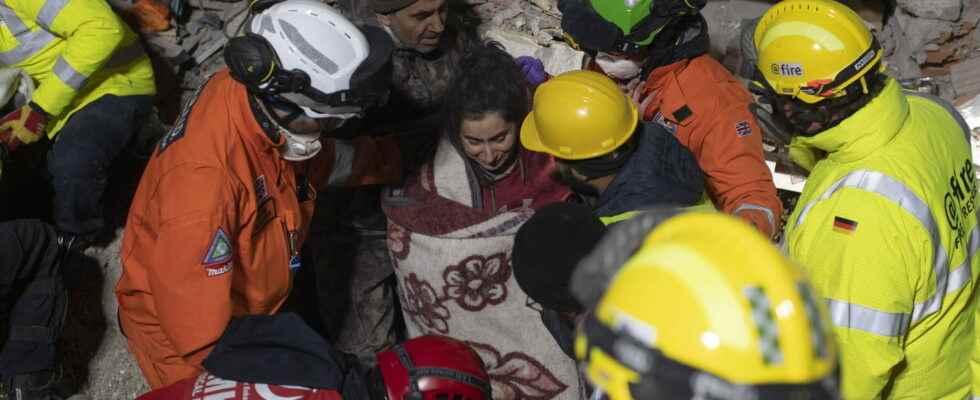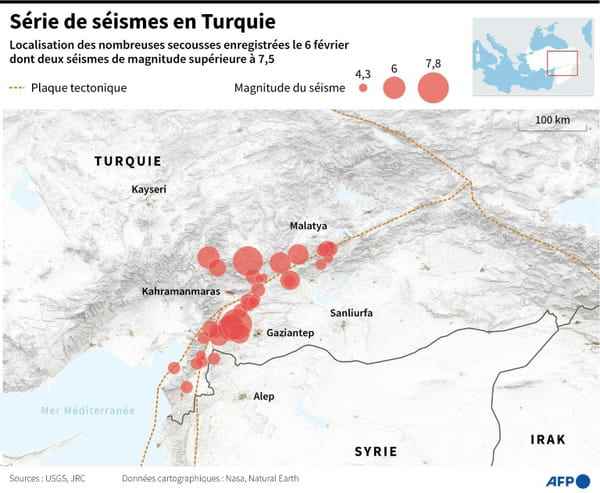TURKEY EARTHQUAKE. The balance sheet of the earthquake which shook Turkey and Syria continues to grow, the authorities count more than 17,000 dead. This Thursday marks the milestone of three days after which the rescues of survivors are fewer but the relief operations continue.
The essential
- The toll from the earthquakes that struck Turkey and Syria on February 6 continues to grow. Thursday, February 9, the latest figures announce the death of 17,000 people.
- In addition, between the two countries, around 55,000 people were injured by the earthquakes and evacuated from the rubble.
- Relief operations continue after the earthquakes in Turkey and Syria but time is against the rescuers. 90% of survivors of a natural disaster are generally saved within three days of the tragedy, according to Professor Ilan Kelman, a member of University College London.
- The freezing cold, the numerous aftershocks and the difficult access to certain disaster areas also complicate the operations of the rescuers who have been joined by international teams over the past two days.
- The latest news live.
Live
13:25 – Emergency aid should arrive this Thursday in rebel areas
The rebel areas of northwest Syria affected by the earthquake have not yet received emergency aid sent by the international community, but the first convoy is due to arrive on Thursday. According to guarantees given by the UN and theAFP, aid must pass through a single border post between Turkey and northwestern Syria, that of Bab al-Hawaa. According to AFP, six trucks loaded with survival equipment, tents, hygiene products and other humanitarian aid are to reach Syria.
12:57 – The quality of buildings responsible for the number of victims of the earthquake in Turkey?
“In general, it is not earthquakes that kill people but the collapse of buildings” recalls Professor Ilan Kelman. A remark that raises the question of the quality of the building and the adequacy of anti-seismic standards. Several seismologists praised the state of Turkish knowledge on earthquakes and recalled that the country regularly plagued by earthquakes has implemented appropriate anti-seismic standards. More than the standards, it is the respect of its construction rules that is called into question by the experts. In Turkey nearly 6,000 buildings have collapsed causing the death of many people. On this point, the Turkish ambassador to France Ali Onaner judged yesterday on Franceinfo that “perhaps we will have to learn lessons and strengthen these standards”.
12:35 – The toll continues to rise after the earthquakes in Turkey
At midday, a new update of the toll was made and the death toll now stands at more than 17,500 in Turkey and Syria.
12:29 – The damage of the earthquake in Turkey seen by satellite images
From the ground, the damage caused by the earthquakes in Turkey is colossal with several thousand buildings collapsed and the extent of the destruction can also be seen on satellite images from Maxar Technologies.
12:01 – More than 17,100 dead in the provisional balance of the earthquake in Turkey
The new official report of the earthquakes in Turkey fell and it weighs down. More than 17,100 people died according to the authorities and the medical teams, 14,014 people died in Turkey while in Syria there are 3,162 bodies found without life. In addition to the deaths, the injured are also very numerous, more than 60,000 in Turkey alone.
11:33 – How do rescuers find earthquake victims?
Once all the most accessible areas in the rubble are evacuated, rescuers spend more time searching for survival pockets and earthquake survivors. Dog squads with dogs trained to spot a human presence are deployed and more and more drones are used to fly over areas more quickly or penetrate places too dangerous to search for victims wherever they might be. The international aid sent to Turkey and Syria concentrates several of these specialized teams.
11:00 – “The majority of survivors are brought back within 24 hours”
After an earthquake like the one that struck Turkey and Syria, “the vast majority of survivors are brought back within 24 hours by local teams, often using only their hands or a shovel”, according to the professor and disaster specialist natural Ilan Kelman. These are the people most easily spotted in accessible areas. The search and rescue then becomes more difficult when the survivors are buried deeper under the rubble.
10:31 – Rescue of earthquake victims in Turkey still possible
While the chances of saving as many people as possible will dwindle in the coming days, rescuers say there is still hope up to 15 days after an earthquake if survivors are in survival pockets. As for the course of 72 hours, it can be modified on a case-by-case basis depending on weather conditions, the number and violence of aftershocks or the duration of the arrival of help. Still, in Turkey as in Syria, these criteria are not good omens because in the middle of winter and aftershocks which were numerous in the first days, the countries were put to the test.
10:14 – Crucial 72-hour milestone in search for earthquake victims
This Thursday, February 9, it will be 72 hours since the earthquakes shook Turkey and Syria and rescuers are looking for victims. This three-day milestone is crucial after a natural disaster, according to University College London (UCL) researcher Ilan Kelman interviewed by France 24, because more than 90% of earthquake survivors are usually rescued within this very short time. It is therefore to be expected that the number of rescued victims will decrease in the coming days.
Learn more
Collapsed buildings and buried victims, rescuers at work
Repeated earthquakes in Turkey have destroyed thousands of buildings and infrastructure, in major Turkish cities alone the authorities count more than 6,000 collapsed buildings. A figure that does not count all the other buildings weakened and ready to fall. Some buildings have cracks that look like fractures. More than the material damage, the victims held under the rubble are worrying. In some places, the emergency services estimate the number of buried people at 200 who are signaled by cries.
According to the Turkish organization in charge of disaster and emergency management, AFAD, 24,400 people are mobilized to participate in rescue operations. These professional and volunteer rescuers are to be joined on Tuesday, February 7 by international teams sent by different nations. Help that will be very useful because rescues are complicated by the freezing cold and weather conditions but also because the area affected by the earthquake extends over hundreds of kilometers.
The rumblings of the Earth have done immense damage in Turkey but also in Syria. More than two days after the first earthquake, the human toll is still provisional but shows more than 17,000 dead according to the authorities. The number of wounded, also provisional, is estimated at more than 50,000 on Turkish land and more than 5,000 on the other side of the border. These figures are still likely to climb because on-site rescue operations are still underway to try to rescue the victims buried under the rubble. If the assessment of the earthquakes in Turkey is already heavy, it will still swell according to the World Health Organization (WHO). The death toll could be “eight times higher than the initial numbers”, according to the words of Catherine Smallwood, head of emergency situations at the European office of the WHO, reported by BFM TVor reach the milestone of 20,000 dead.
In addition to the physical victims of the earthquakes, the WHO estimates that 23 million people could be affected by the consequences of the earthquake in Turkey and Syria. “Event maps show that 23 million people are potentially at risk, including around 5 million vulnerable people,” Adelheid Marschang, a WHO official, said on Tuesday, February 7.
Turkey has, in the hours following the earthquake, made security arrangements and mobilized all its rescuers. Turkish Interior Minister Süleyman Soylu has gone so far as to issue a level four alert which involves a call for international assistance. A call heard by dozens of countries and the European Union, which was the first to announce the dispatch of teams of rescuers, a position shared in the process by all or almost all European nations. In France, President Emmanuel Macron has promised to send “emergency aid to the populations” and more than a hundred rescuers are due to arrive in Turkey on February 7. Volunteer troops from the International Emergency Fire Department also make the trip.
In addition to Europe, Ukraine and Russia, at war, have offered to send all “necessary aid”. As well as China via the Chinese foreign aid agency, India, Iran or Azerbaijan. In Israel, Prime Minister Benjamin Netanyahu “ordered all authorities to immediately prepare to provide medical assistance and relief” and “approved” the dispatch of aid to enemy country Syria.
The first earthquake in Turkey, that of magnitude 7.8, occurred in the district of Pazarcik, in the south-east of Turkey, located about sixty kilometers with the Syrian border and 17.9 kilometers deep according to the the American Institute of Geophysics (USGS). However, the force of the earthquake was felt even in neighboring countries such as Jordan, Lebanon and Cyprus.
A few hours later, the second earthquake started about a hundred kilometers from the epicenter of the first. With a magnitude of 7.5, the earthquake shook a large part of Anatolia: from Ankara and Diyarbakır, cities 670 kilometers apart from east to west, and from Malatya to Adana separated by 300 kilometers from north to south .

